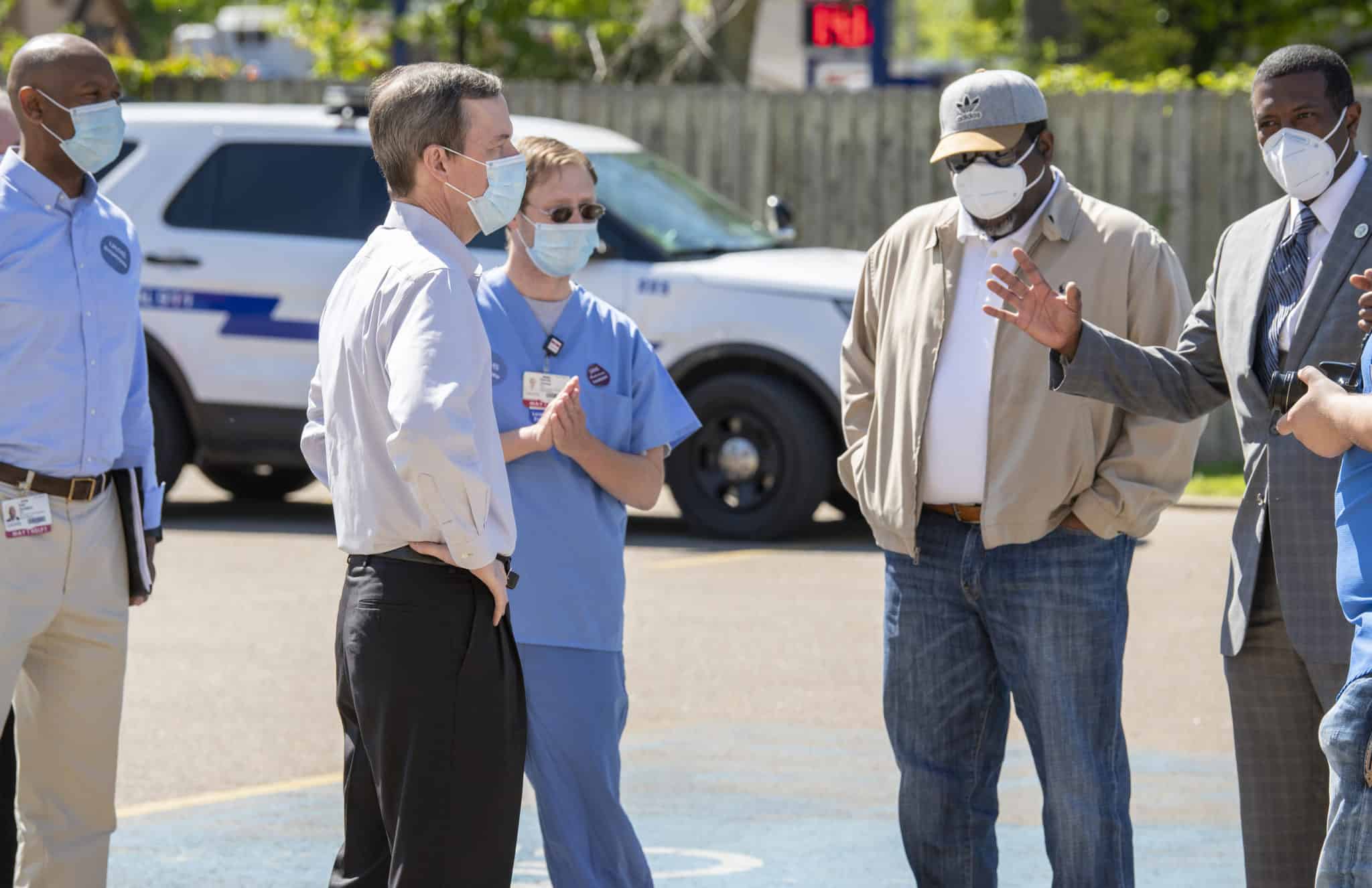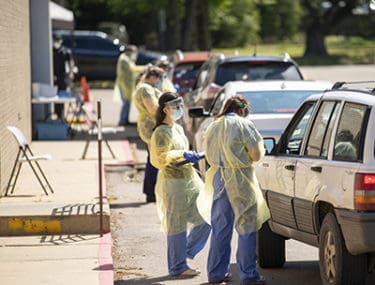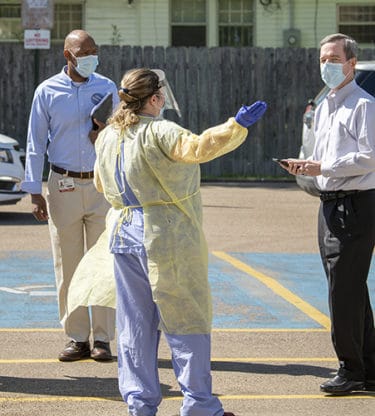View Larger Image

UAMS Chancellor Cam Patterson, second from left, talks with Forrest City Mayor Cedric Williams, far right, and State Rep. Reginald Murdock, second from right, April 16 in Forrest City.
Image by Bryan Clifton
UAMS Provides COVID-19 Mobile Triage Evaluation to Forrest City, Delta
| As one who has recovered from COVID-19, state Rep. Reginald Murdock, of Marianna, knows the importance of the COVID-19 screening and testing UAMS provided April 16 to Forrest City residents.
“The citizens are doing the right thing by making sure they get screened and tested, so we can continue to try to slam this curve flat,” he said as cars lined up outside the city’s Civic Center for screening.

UAMS nurses and physicians provide drive-through, COVID-19 evaluations outside the Forrest City Civic Center.Image by Bryan Clifton
Murdock, who represents Lee and St. Francis counties, was ill earlier this month for about three days with some mild symptoms including body aches and congestion. He tested positive for COVID-19 and several days ago tested negative.
He discussed it with Forrest City Mayor Cedric Williams before going public. “We talked about it and being the example for people. I wasn’t trying to be the sacrificial lamb but God chose it that way.”
Murdock and Williams wore facial masks as they stood just inside the Civic Center.
“This is a big benefit today for UAMS to come here and provide this testing service,” Williams said. “We have had some local testing, but like most Delta towns, access and the testing capability of local providers has limited the amount of testing in our area. People in the community who have come down with COVID-19 have shared their stories like Representative Murdock here and have made it real.”
UAMS Chancellor Cam Patterson, M.D., MBA, also was at the screening and Murdock got a chance to thank Patterson in person.
“UAMS has been wonderful,” Murdock said. “The chancellor texted me immediately on hearing about my health. He’s been very supportive. What he has done in Arkansas and in the Delta has been so important. He always has been a great teammate.”
At the drive through entrance, residents were seen by one of the nurses then drove into the service area in front of the Civic Center to be asked a series of screening questions by one of the UAMS physicians on site. Their condition and answers determined if they needed testing, performed by experienced nurses who obtain a specimen with a swab of the back part of the nose.

UAMS Chancellor Cam Patterson, right, talks with two UAMS employees during the drive-through in Forrest City.Image by Bryan Clifton
The tests were taken back to UAMS for processing and follow-up with the patients with their results in a couple of days. No patient had to get out of their vehicle, and all the screeners were equipped and wearing personal protective equipment (PPE) such as masks, eye protection, gloves and disposable medical gowns.
“Dr. Jennifer Hunt and her team have jumped on the ball to get this process of screening and testing rolling,” Patterson said. “Representative Murdock reached out because of the outbreak in the Federal Correctional Institution in Forrest City, and we realized there was a lot of anxiety in the community here. On Tuesday, we arranged this and we’re here on Thursday, so we got it done.”
Hunt is chair of the UAMS College of Medicine Department of Pathology and Laboratory Services and director of the UAMS Triage Unit. She led the team in Forrest City as she has at drive-throughs in Helena and Texarkana earlier in April.
UAMS nurses and physicians screened 120 people and tested about 50 by the time the drive-through concluded at 2 p.m.
“I think our planning and set-up for mobile testing is getting even smoother,” Hunt said. “We haven’t changed our processes since the first screening in Helena, but we’re getting efficient with experience. We now use iPads to get into the electronic health record. These are great and make us much more nimble to be able to keep the cars flowing in the line.”
The mobile Triage Unit will conduct drive-through screening in McGehee on Monday, Marianna on Tuesday and East Camden on Wednesday.
“UAMS as a statewide institution has stepped up to the plate. We have regional campuses all across the state and in some of the regions they cover there are regional partner hospitals who work with us on screening and testing, but there are locations where those opportunities don’t exist, Forrest City being one of them,” Patterson said. “We’re choosing sites based on the needs in those communities and where those communities can’t meet these needs themselves.”